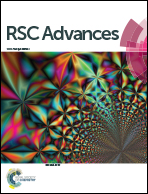Palladium-based micellar nanohybrids: preparation and nonlinear optical response
Abstract
In the present work the synthesis and physicochemical characterisation of a new class of Pd-containing micellar nanohybrid systems are presented. The new systems consist of metallic Pd nanoparticles and well-defined diblock copolymers, possessing carbazole and β-ketoester side-chain functionalities, namely poly[2-(N-carbazolyl) ethyl methacrylate]-block-poly[2-(acetoacetoxy) ethyl methacrylate] (CbzEMAx-b-AEMAy). Block copolymer synthesis has been carried out by Reversible Addition–Fragmentation chain Transfer (RAFT) polymerisation. The presence of the β-ketoester groups within these diblock copolymers enabled the complexation and stabilisation of the Pd nanoparticles in tetrahydrofuran. Visualisation of the Pd-containing micellar nanohybrids was realised by means of transmission electron microscopy (TEM), providing information on the metal nanoparticle sizes. The nonlinear optical response of these polymer–metal nanohybrid systems has been systematically studied both in solution and in thin films, using the Z-scan technique, employing 35 ps, visible (532 nm) and infrared (1064 nm) laser excitation. Discussion in regards to the spectral position of the surface plasmon resonance (SPR) of the Pd nanoparticles and its effect on the nonlinear optical response of the micellar systems has been carried out in terms of a two-photon process.


 Please wait while we load your content...
Please wait while we load your content...